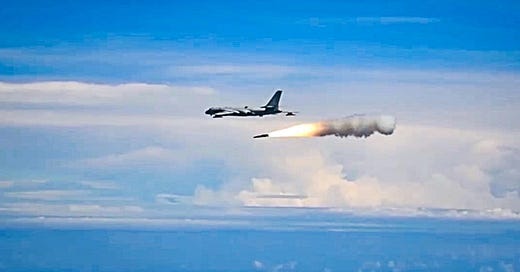Briefing: China's Upcoming Hypersonic Air-Launched Ballistic Missile
Assessing the Emerging Hypersonic Threat in the Indo-Pacific
Overview
China is reportedly developing a hypersonic air-launched missile, which could significantly enhance its military capabilities. The designation for this missile is believed to be “KD-21”. The development of such a missile aligns with China's broader strategy to modernize its military and assert its influence in the Indo-Pacific region. Over the past decade, China has made substantial investments in advanced technologies, including hypersonic systems, which are critical for maintaining strategic parity with other major powers. The potential deployment of a hypersonic air-launched missile would underscore China's commitment to expanding its military reach and challenging existing power dynamics in the region.
Potential Capabilities
Speed and Range: Hypothetically, such a missile could achieve speeds between Mach 4 and Mach 6, with a range potentially exceeding 1,000 kilometers. This would allow it to target strategic assets across the Indo-Pacific from a safe distance.
Guidance System: It is speculated that advanced guidance systems, including active radar seekers and synthetic aperture radar (SAR) technology, will be incorporated, enabling precise targeting of both moving and fixed targets.
Carriage and Deployment: Analysts believe it could be carried by China's H-6K bomber or other advanced aircraft, significantly expanding China's strike capabilities.
Comparisons with Other Countries' Capabilities
Russia's Kinzhal: If China's missile shares similarities with Russia's Kinzhal, it could offer comparable strategic advantages, such as targeting enemy ships and bases from beyond the range of most air defenses.
U.S. Countermeasures: The U.S. would likely face challenges in countering such a missile due to its potential speed and maneuverability, necessitating the development of new defense technologies.
Threat to U.S. Military Assets
Aircraft Carriers and Bases: A hypersonic missile would pose a significant threat to U.S. aircraft carriers and air bases in the Western Pacific, complicating U.S. military operations in the region.
Stealth Aircraft Vulnerability: As an air-to-air missile, the existence of such a weapon could directly challenge the effectiveness of U.S. stealth aircraft by highlighting the broader vulnerability to hypersonic threats.
Operational Challenges: The potential speed and maneuverability of the missile would require the U.S. to reassess its air defense strategies and develop more effective countermeasures.
Strategic Implications
Anti-Access/Area-Denial (A2/AD) Strategy: If properly developed, this missile would likely be a key component of China's A2/AD strategy, aimed at limiting U.S. power projection in the Indo-Pacific by threatening critical military assets.
Regional Deterrence: It could enhance China's deterrence posture, particularly against Taiwan and Japan, by providing a long-range precision strike capability that can be deployed from safer distances.
Conclusion
In conclusion, while information is still being rolled out about China's possible hypersonic air-launched missile, its potential development underscores the need for vigilance and strategic planning by the U.S. and its allies to address emerging threats in the Indo-Pacific. The implications of such a missile would be far-reaching, necessitating a comprehensive review of current defense strategies and the development of new technologies to counter hypersonic threats effectively.
The ongoing development of China's hypersonic missile program highlights the broader race for technological superiority in the military sphere. As countries like China, Russia, and the U.S. continue to invest in advanced weapons systems, the strategic landscape is likely to become increasingly complex. This environment demands not only technological innovation but also diplomatic efforts to manage tensions and prevent miscalculations that could escalate into conflict. The U.S. and its allies must remain proactive in developing countermeasures and fostering international dialogue to ensure stability in the face of emerging threats.
Source Material
China’s KD-21 missile puts US carriers and bases at range
China Says Conducted Final Test of Secretive Hypersonic Air-to-Air Missile
China tests new air-launched hypersonic missile
China runs final tests of hypersonic air-to-air missile in extreme Mars mission tunnel




